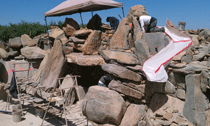|
| This mailer has been provided as an avenue of dispersing information related to landscape architecture in hopes of fostering greater understanding and collaboration between professions. Topics address issues that affect the built environment within which we live. |
|
Inclusive Play Community Series: Intergenerational Play
"The debt we owe to the play of imagination is incalculable." Carl Jung
The benefits of intergenerational play - The basic intent of intergenerational play is the strengthening of the family relationship, which has been shown in study after study to be most effectively accomplished through family leisure events that are "unique, shared, interactive, purposive, challenging and requiring sacrifice".2 It is these opportunities that facilitate the learning and teaching of life skills and lessons learned as well as family narratives and values. Other benefits of intergenerational play are well documented for both children and their adult counterparts. Children: "Children, meanwhile, gain an emerging sense of empathy, including a more positive attitude toward aging...children participating in intergenerational activities display a higher level of maturity and manners than their peers, improved academic performance, and greater self-control and patience."5
Adults: "Adults, particularly seniors, benefit from enhanced socialization, a greater sense of engagement in their communities, and better emotional, mental and physical health than their non-participating contemporaries. Often placed in mentoring roles, adults maintain their mature status and are tapped for their wisdom and experience, a reality that delivers an enhanced sense of purpose and dignity."5 In addition to all of these benefits, intergenerational programming has been used for some time now in the health care profession resulting in benefits for everyone involved including: positive mood changes, improved cognitive, social and emotional development and increased levels of engagement, even among frail seniors.3 The source of all these benefits, intergenerational play, can be defined briefly as follows. What is Intergenerational play?
Implementation - Research related to intergenerational play is lacking and unfortunately not enough space can be dedicated here to adequately address this topic. This being said, the following suggestions, based on available research, have been prepared to help guide implementation of intergenerational play spaces:
The concept of intergenerational play is geared at improved interaction between generations, particularly within the family. Specific activities or completion of them (though they are important to plan for) are peripheral and should be loose in nature. With thoughtful planning, perhaps there will be less sideline watching and more giggles, laughter and fun in our play spaces, where adults and children establish lasting memories together! 1-Davis, Hilary PhD, Frank Vetere PhD, Peter Francis, Martin Gibbs PhD & Steve Howard PhD (2008): "I Wish We Could Get Together": Exploring Intergenerational Play Across a Distance via a 'Magic Box', Journal of Intergenerational Relationships, 6:2, 191-210 2-Hebblethwaite, Shannon and Joan Norris (2011): "Expressions of Generativity Through Family Leisure: Experiences of Grandparents and Adult Grandchildren". Family Relations, 60:121-133 3-Listokin, Janet MSCTRS (2011): Project N.O.I.S.E.E.sm: Intergenerational Laughter, Squeals and Giggles, Journal of Intergenerational Relationships, 9:4, 476-480 4-Sinem Siyahhan, Sash A. Barab, & Michael P. Downton (2010): "Using Activity Theory to Understand Intergenerational Play: The Case of Family Quest", Computer-Supported Collaborative Learning, 5:415-432. 5-Smith, Daniel (2010): "Generation Recreation: From Multigenerational to Intergenerational Programming", Recreation Management, February :03. 6-Spence, Lynda and Heidi Liss Radunovich (2007): "Developing Intergenerational Relationships", University of Florida IFAS Extension, FCS2282. |
|
|
|
|
|
|
|
|
|
|
|
|
|
|
|
|
|
|
|
|
|
|
| Author: Chad Kennedy, Landscape Architect |
 As a father of young children, afternoons spent at local parks and playgrounds are not an uncommon occurrence. Months ago, while chasing my children up, down and around chutes and ladders, I suddenly noticed a concerning trend that has fascinated me ever since. Many of the other parents and grandparents, if not all of them, were sitting on the sidelines engrossed in their smart phones and other electronic devices. The playground, for all intents and purposes, was now the children's babysitter, responsible for entertaining the children while adults performed other more worthwhile tasks. I was perhaps most taken back by the fact that I myself have been guilty of checking e-mails and updates while "watching" the children play. Why is it that in so many cases only the children are recreating on the playground? My un-scrutinized hypothesis is that in our modern play spaces, adults are less engaged because of the lack of multi-generational activities, actual or perceived physical barriers and/or a lack of appealing recreational opportunities. A possible solution to this phenomenon may include the creation of intergenerational play spaces. This article will discuss what inter-generational play is, what the benefits of it are, and ways that it might be encouraged in public outdoor settings.
As a father of young children, afternoons spent at local parks and playgrounds are not an uncommon occurrence. Months ago, while chasing my children up, down and around chutes and ladders, I suddenly noticed a concerning trend that has fascinated me ever since. Many of the other parents and grandparents, if not all of them, were sitting on the sidelines engrossed in their smart phones and other electronic devices. The playground, for all intents and purposes, was now the children's babysitter, responsible for entertaining the children while adults performed other more worthwhile tasks. I was perhaps most taken back by the fact that I myself have been guilty of checking e-mails and updates while "watching" the children play. Why is it that in so many cases only the children are recreating on the playground? My un-scrutinized hypothesis is that in our modern play spaces, adults are less engaged because of the lack of multi-generational activities, actual or perceived physical barriers and/or a lack of appealing recreational opportunities. A possible solution to this phenomenon may include the creation of intergenerational play spaces. This article will discuss what inter-generational play is, what the benefits of it are, and ways that it might be encouraged in public outdoor settings.  Elements of Intergenerational Play: The fundamental elements of intergenerational play revolve around a diverse and flexible palette of activities that appeal to a broad demographic. This does not imply a shotgun approach of cramming as many recreational features as possible into a space. Thoughtful design will create spaces and features that function in versatile ways engaging multiple generations in activity together. Activities and recreational features should:
Elements of Intergenerational Play: The fundamental elements of intergenerational play revolve around a diverse and flexible palette of activities that appeal to a broad demographic. This does not imply a shotgun approach of cramming as many recreational features as possible into a space. Thoughtful design will create spaces and features that function in versatile ways engaging multiple generations in activity together. Activities and recreational features should:

